IoT in Digital Strategy: Benefits and Challenges for SMEs Report
VerifiedAdded on 2022/09/18
|18
|4753
|21
Report
AI Summary
This report explores how small to medium enterprises (SMEs) can leverage the Internet of Things (IoT) to enhance their digital strategies. It begins by defining key concepts such as IoT and digital strategy, emphasizing the importance of a cohesive digital strategy for reaching target audiences cost-effectively. The report then delves into three specific technologies: big data and analytics, artificial intelligence (AI), and cloud-based work platforms supporting remote working. For each technology, the report explains its functionality, benefits for businesses (including increased ROI, improved e-health, manufacturing advantages, and transportation optimization), and challenges during implementation (such as data synchronization, professional shortages, data quality issues, and security concerns). The analysis provides a comprehensive overview of how IoT can be strategically integrated into SMEs to drive innovation and improve overall business performance.
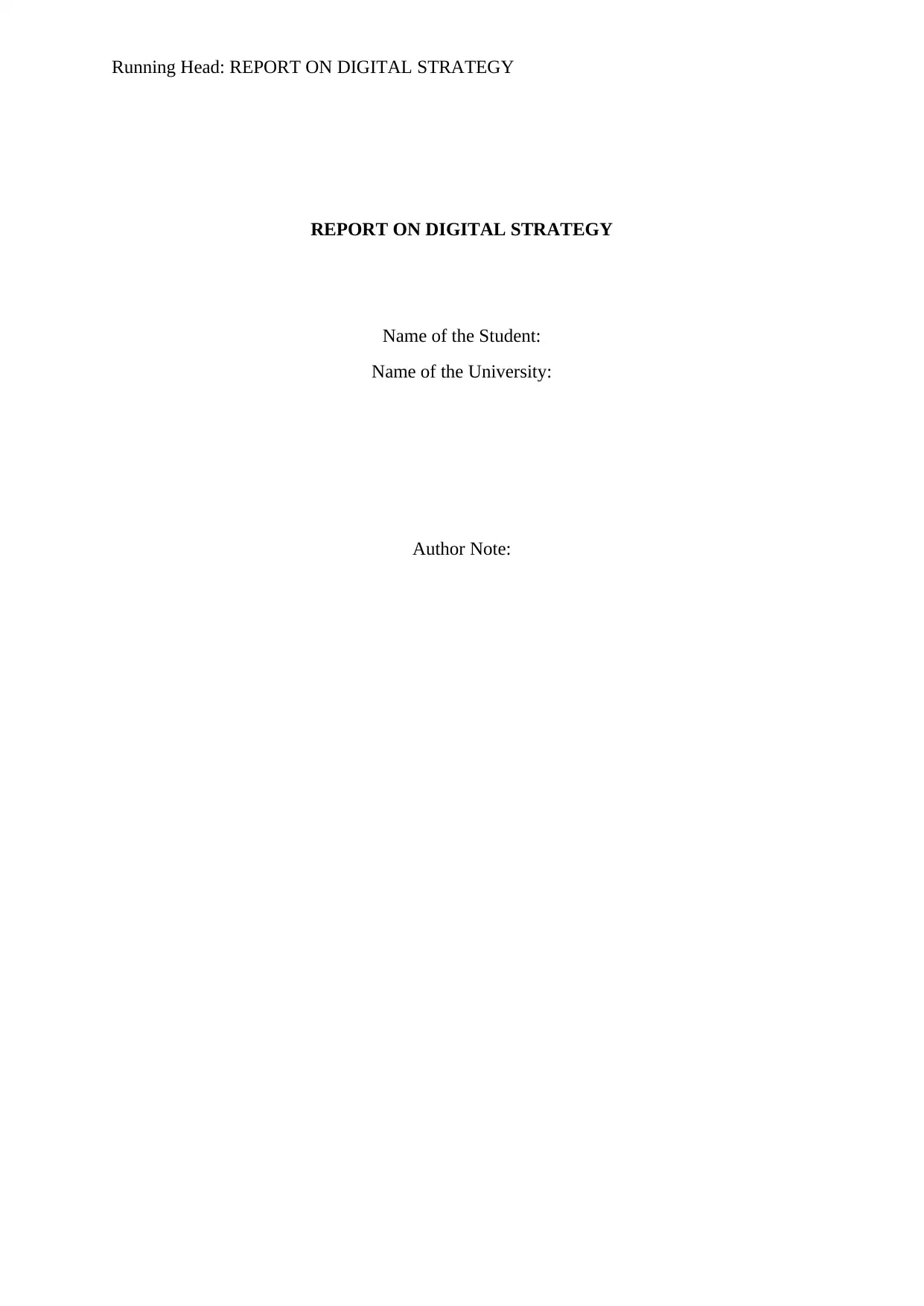
Running Head: REPORT ON DIGITAL STRATEGY
REPORT ON DIGITAL STRATEGY
Name of the Student:
Name of the University:
Author Note:
REPORT ON DIGITAL STRATEGY
Name of the Student:
Name of the University:
Author Note:
Paraphrase This Document
Need a fresh take? Get an instant paraphrase of this document with our AI Paraphraser
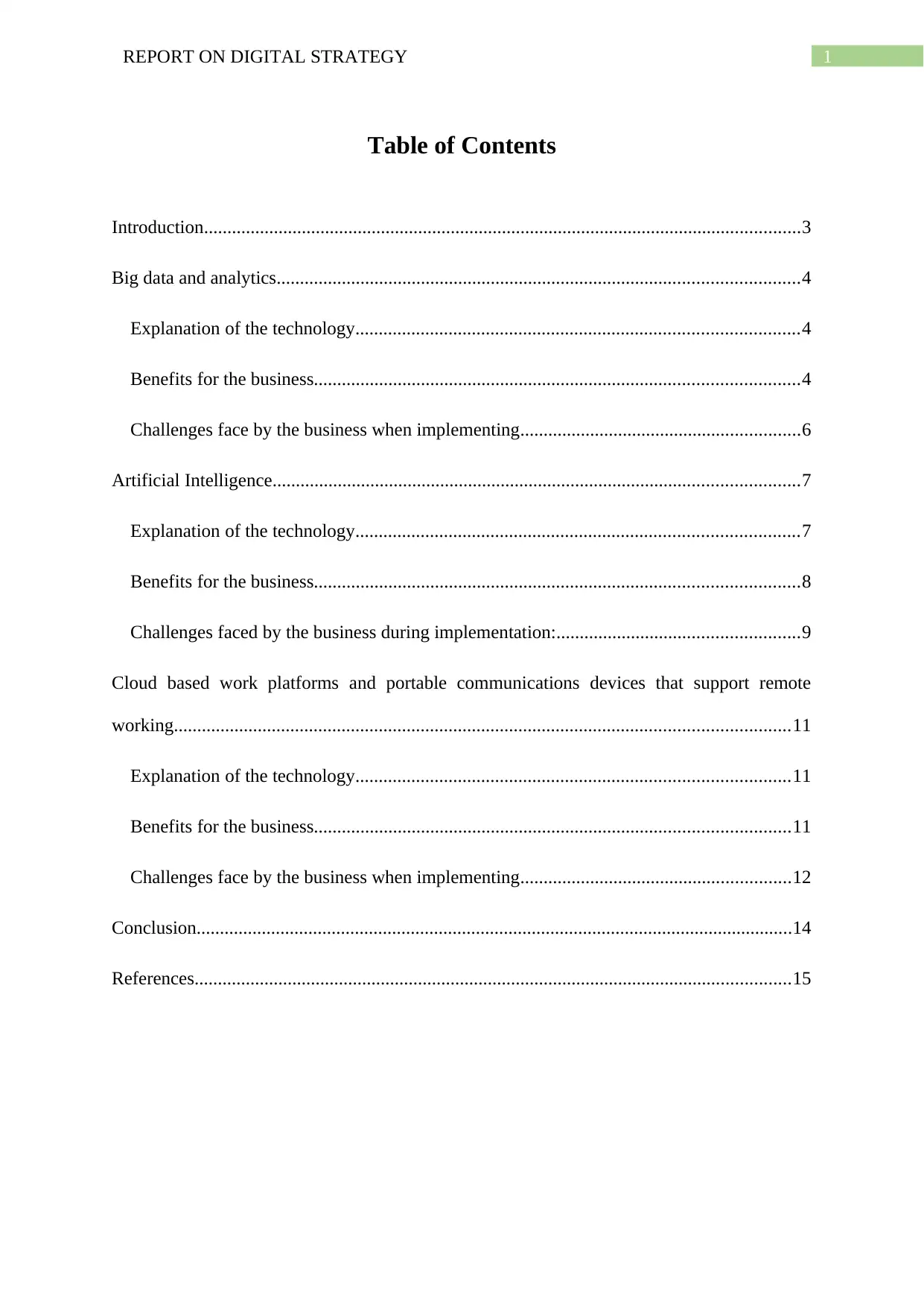
1REPORT ON DIGITAL STRATEGY
Table of Contents
Introduction................................................................................................................................3
Big data and analytics................................................................................................................4
Explanation of the technology...............................................................................................4
Benefits for the business........................................................................................................4
Challenges face by the business when implementing............................................................6
Artificial Intelligence.................................................................................................................7
Explanation of the technology...............................................................................................7
Benefits for the business........................................................................................................8
Challenges faced by the business during implementation:....................................................9
Cloud based work platforms and portable communications devices that support remote
working....................................................................................................................................11
Explanation of the technology.............................................................................................11
Benefits for the business......................................................................................................11
Challenges face by the business when implementing..........................................................12
Conclusion................................................................................................................................14
References................................................................................................................................15
Table of Contents
Introduction................................................................................................................................3
Big data and analytics................................................................................................................4
Explanation of the technology...............................................................................................4
Benefits for the business........................................................................................................4
Challenges face by the business when implementing............................................................6
Artificial Intelligence.................................................................................................................7
Explanation of the technology...............................................................................................7
Benefits for the business........................................................................................................8
Challenges faced by the business during implementation:....................................................9
Cloud based work platforms and portable communications devices that support remote
working....................................................................................................................................11
Explanation of the technology.............................................................................................11
Benefits for the business......................................................................................................11
Challenges face by the business when implementing..........................................................12
Conclusion................................................................................................................................14
References................................................................................................................................15

2REPORT ON DIGITAL STRATEGY
⊘ This is a preview!⊘
Do you want full access?
Subscribe today to unlock all pages.

Trusted by 1+ million students worldwide
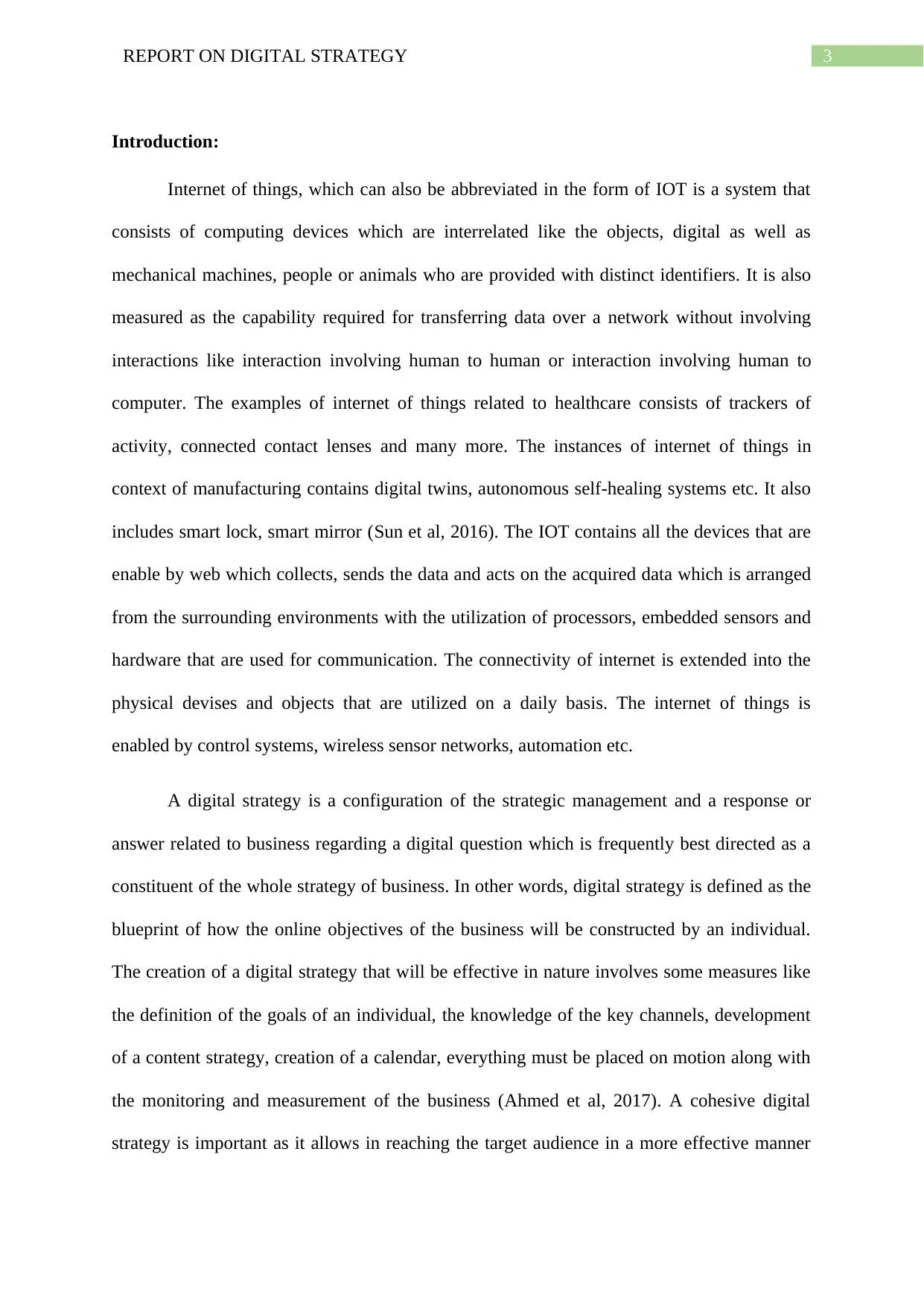
3REPORT ON DIGITAL STRATEGY
Introduction:
Internet of things, which can also be abbreviated in the form of IOT is a system that
consists of computing devices which are interrelated like the objects, digital as well as
mechanical machines, people or animals who are provided with distinct identifiers. It is also
measured as the capability required for transferring data over a network without involving
interactions like interaction involving human to human or interaction involving human to
computer. The examples of internet of things related to healthcare consists of trackers of
activity, connected contact lenses and many more. The instances of internet of things in
context of manufacturing contains digital twins, autonomous self-healing systems etc. It also
includes smart lock, smart mirror (Sun et al, 2016). The IOT contains all the devices that are
enable by web which collects, sends the data and acts on the acquired data which is arranged
from the surrounding environments with the utilization of processors, embedded sensors and
hardware that are used for communication. The connectivity of internet is extended into the
physical devises and objects that are utilized on a daily basis. The internet of things is
enabled by control systems, wireless sensor networks, automation etc.
A digital strategy is a configuration of the strategic management and a response or
answer related to business regarding a digital question which is frequently best directed as a
constituent of the whole strategy of business. In other words, digital strategy is defined as the
blueprint of how the online objectives of the business will be constructed by an individual.
The creation of a digital strategy that will be effective in nature involves some measures like
the definition of the goals of an individual, the knowledge of the key channels, development
of a content strategy, creation of a calendar, everything must be placed on motion along with
the monitoring and measurement of the business (Ahmed et al, 2017). A cohesive digital
strategy is important as it allows in reaching the target audience in a more effective manner
Introduction:
Internet of things, which can also be abbreviated in the form of IOT is a system that
consists of computing devices which are interrelated like the objects, digital as well as
mechanical machines, people or animals who are provided with distinct identifiers. It is also
measured as the capability required for transferring data over a network without involving
interactions like interaction involving human to human or interaction involving human to
computer. The examples of internet of things related to healthcare consists of trackers of
activity, connected contact lenses and many more. The instances of internet of things in
context of manufacturing contains digital twins, autonomous self-healing systems etc. It also
includes smart lock, smart mirror (Sun et al, 2016). The IOT contains all the devices that are
enable by web which collects, sends the data and acts on the acquired data which is arranged
from the surrounding environments with the utilization of processors, embedded sensors and
hardware that are used for communication. The connectivity of internet is extended into the
physical devises and objects that are utilized on a daily basis. The internet of things is
enabled by control systems, wireless sensor networks, automation etc.
A digital strategy is a configuration of the strategic management and a response or
answer related to business regarding a digital question which is frequently best directed as a
constituent of the whole strategy of business. In other words, digital strategy is defined as the
blueprint of how the online objectives of the business will be constructed by an individual.
The creation of a digital strategy that will be effective in nature involves some measures like
the definition of the goals of an individual, the knowledge of the key channels, development
of a content strategy, creation of a calendar, everything must be placed on motion along with
the monitoring and measurement of the business (Ahmed et al, 2017). A cohesive digital
strategy is important as it allows in reaching the target audience in a more effective manner
Paraphrase This Document
Need a fresh take? Get an instant paraphrase of this document with our AI Paraphraser
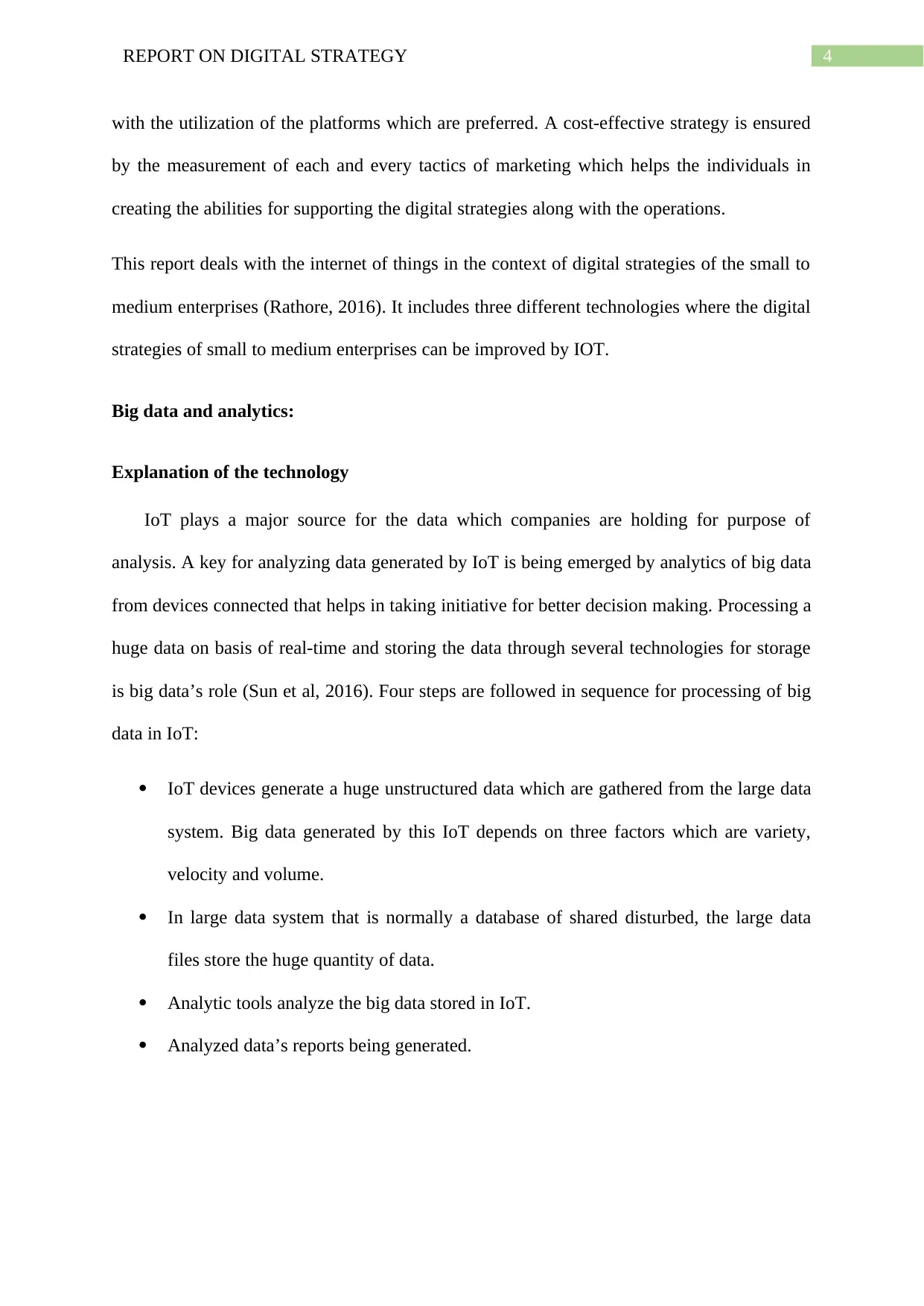
4REPORT ON DIGITAL STRATEGY
with the utilization of the platforms which are preferred. A cost-effective strategy is ensured
by the measurement of each and every tactics of marketing which helps the individuals in
creating the abilities for supporting the digital strategies along with the operations.
This report deals with the internet of things in the context of digital strategies of the small to
medium enterprises (Rathore, 2016). It includes three different technologies where the digital
strategies of small to medium enterprises can be improved by IOT.
Big data and analytics:
Explanation of the technology
IoT plays a major source for the data which companies are holding for purpose of
analysis. A key for analyzing data generated by IoT is being emerged by analytics of big data
from devices connected that helps in taking initiative for better decision making. Processing a
huge data on basis of real-time and storing the data through several technologies for storage
is big data’s role (Sun et al, 2016). Four steps are followed in sequence for processing of big
data in IoT:
IoT devices generate a huge unstructured data which are gathered from the large data
system. Big data generated by this IoT depends on three factors which are variety,
velocity and volume.
In large data system that is normally a database of shared disturbed, the large data
files store the huge quantity of data.
Analytic tools analyze the big data stored in IoT.
Analyzed data’s reports being generated.
with the utilization of the platforms which are preferred. A cost-effective strategy is ensured
by the measurement of each and every tactics of marketing which helps the individuals in
creating the abilities for supporting the digital strategies along with the operations.
This report deals with the internet of things in the context of digital strategies of the small to
medium enterprises (Rathore, 2016). It includes three different technologies where the digital
strategies of small to medium enterprises can be improved by IOT.
Big data and analytics:
Explanation of the technology
IoT plays a major source for the data which companies are holding for purpose of
analysis. A key for analyzing data generated by IoT is being emerged by analytics of big data
from devices connected that helps in taking initiative for better decision making. Processing a
huge data on basis of real-time and storing the data through several technologies for storage
is big data’s role (Sun et al, 2016). Four steps are followed in sequence for processing of big
data in IoT:
IoT devices generate a huge unstructured data which are gathered from the large data
system. Big data generated by this IoT depends on three factors which are variety,
velocity and volume.
In large data system that is normally a database of shared disturbed, the large data
files store the huge quantity of data.
Analytic tools analyze the big data stored in IoT.
Analyzed data’s reports being generated.
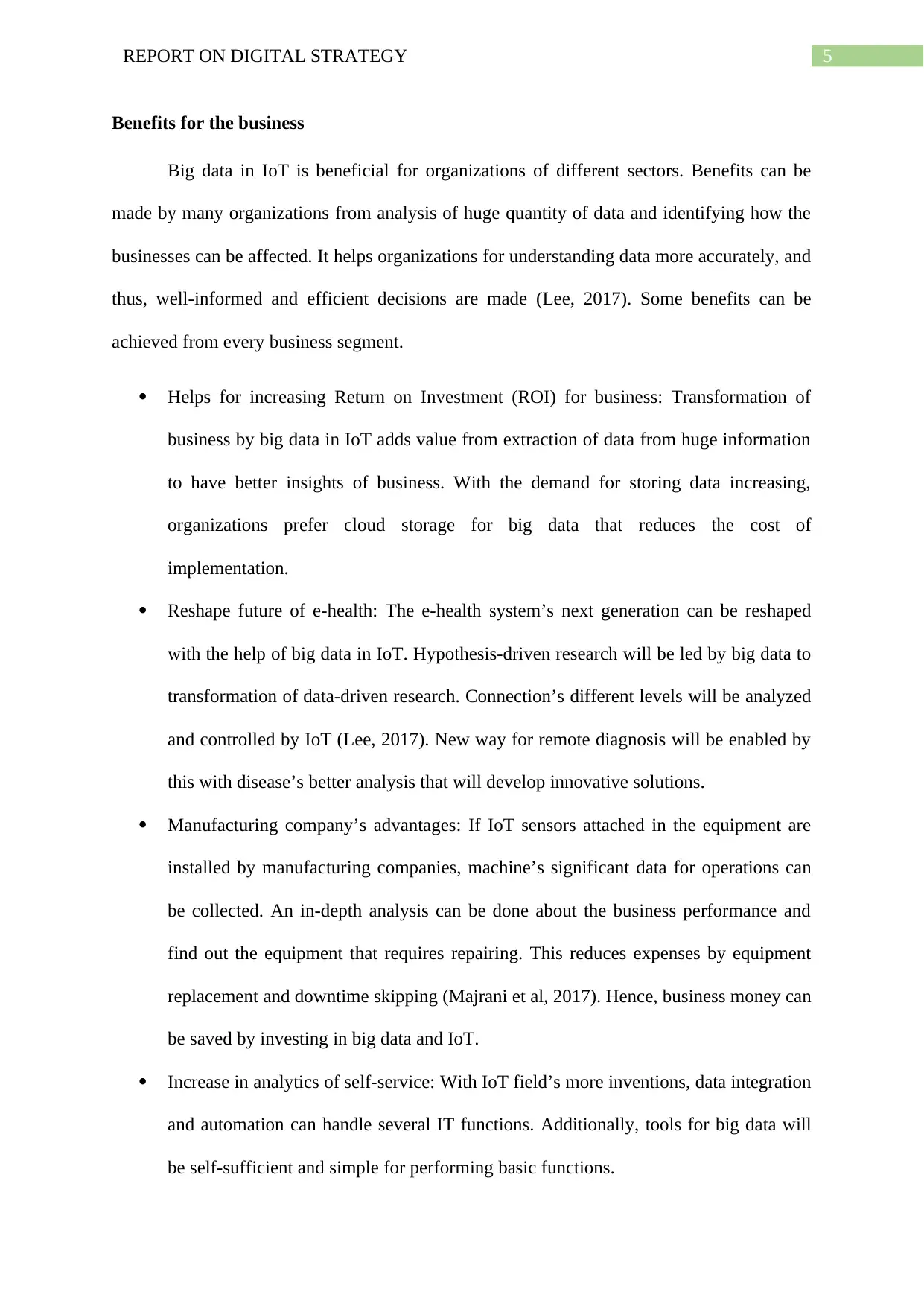
5REPORT ON DIGITAL STRATEGY
Benefits for the business
Big data in IoT is beneficial for organizations of different sectors. Benefits can be
made by many organizations from analysis of huge quantity of data and identifying how the
businesses can be affected. It helps organizations for understanding data more accurately, and
thus, well-informed and efficient decisions are made (Lee, 2017). Some benefits can be
achieved from every business segment.
Helps for increasing Return on Investment (ROI) for business: Transformation of
business by big data in IoT adds value from extraction of data from huge information
to have better insights of business. With the demand for storing data increasing,
organizations prefer cloud storage for big data that reduces the cost of
implementation.
Reshape future of e-health: The e-health system’s next generation can be reshaped
with the help of big data in IoT. Hypothesis-driven research will be led by big data to
transformation of data-driven research. Connection’s different levels will be analyzed
and controlled by IoT (Lee, 2017). New way for remote diagnosis will be enabled by
this with disease’s better analysis that will develop innovative solutions.
Manufacturing company’s advantages: If IoT sensors attached in the equipment are
installed by manufacturing companies, machine’s significant data for operations can
be collected. An in-depth analysis can be done about the business performance and
find out the equipment that requires repairing. This reduces expenses by equipment
replacement and downtime skipping (Majrani et al, 2017). Hence, business money can
be saved by investing in big data and IoT.
Increase in analytics of self-service: With IoT field’s more inventions, data integration
and automation can handle several IT functions. Additionally, tools for big data will
be self-sufficient and simple for performing basic functions.
Benefits for the business
Big data in IoT is beneficial for organizations of different sectors. Benefits can be
made by many organizations from analysis of huge quantity of data and identifying how the
businesses can be affected. It helps organizations for understanding data more accurately, and
thus, well-informed and efficient decisions are made (Lee, 2017). Some benefits can be
achieved from every business segment.
Helps for increasing Return on Investment (ROI) for business: Transformation of
business by big data in IoT adds value from extraction of data from huge information
to have better insights of business. With the demand for storing data increasing,
organizations prefer cloud storage for big data that reduces the cost of
implementation.
Reshape future of e-health: The e-health system’s next generation can be reshaped
with the help of big data in IoT. Hypothesis-driven research will be led by big data to
transformation of data-driven research. Connection’s different levels will be analyzed
and controlled by IoT (Lee, 2017). New way for remote diagnosis will be enabled by
this with disease’s better analysis that will develop innovative solutions.
Manufacturing company’s advantages: If IoT sensors attached in the equipment are
installed by manufacturing companies, machine’s significant data for operations can
be collected. An in-depth analysis can be done about the business performance and
find out the equipment that requires repairing. This reduces expenses by equipment
replacement and downtime skipping (Majrani et al, 2017). Hence, business money can
be saved by investing in big data and IoT.
Increase in analytics of self-service: With IoT field’s more inventions, data integration
and automation can handle several IT functions. Additionally, tools for big data will
be self-sufficient and simple for performing basic functions.
⊘ This is a preview!⊘
Do you want full access?
Subscribe today to unlock all pages.

Trusted by 1+ million students worldwide
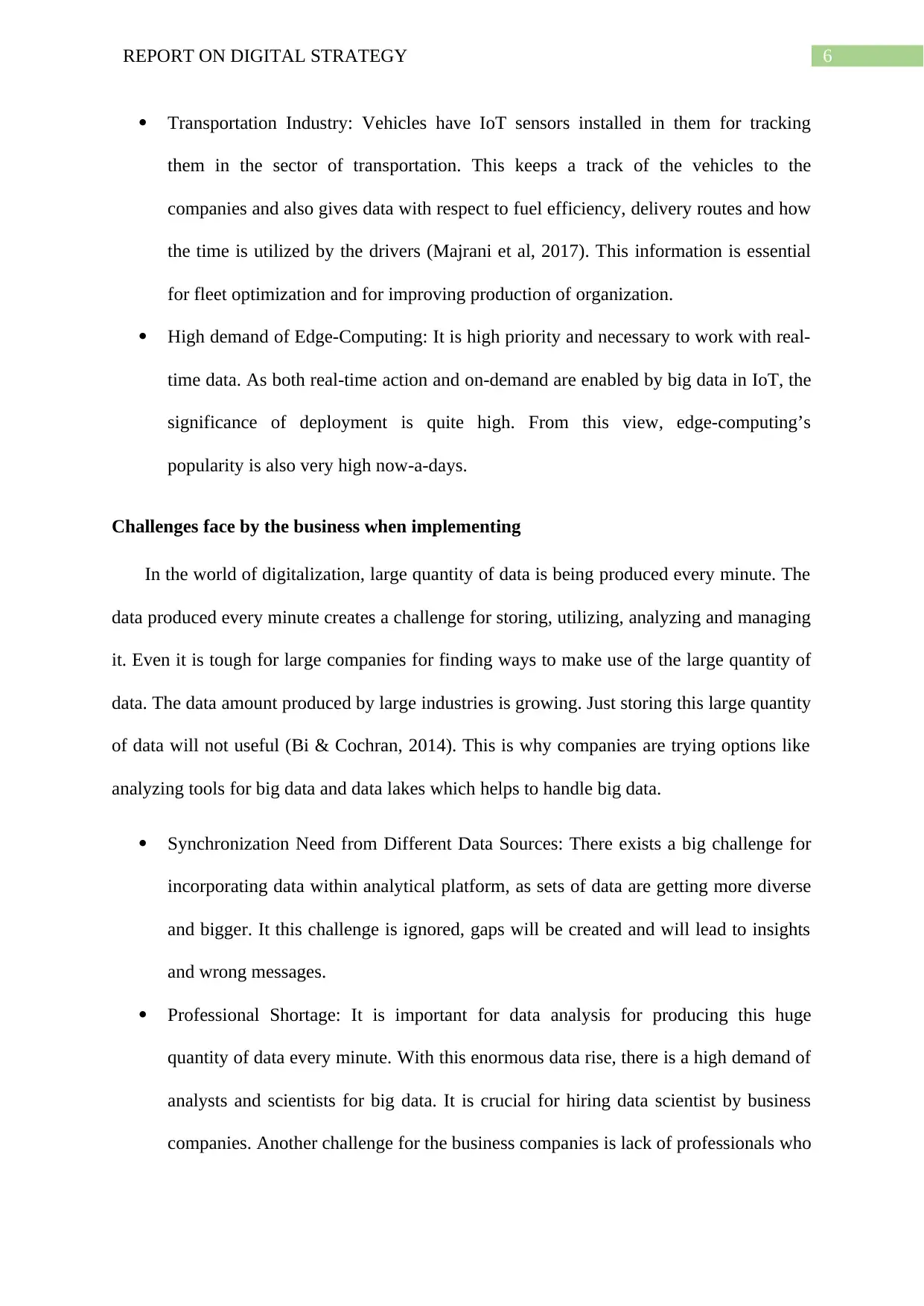
6REPORT ON DIGITAL STRATEGY
Transportation Industry: Vehicles have IoT sensors installed in them for tracking
them in the sector of transportation. This keeps a track of the vehicles to the
companies and also gives data with respect to fuel efficiency, delivery routes and how
the time is utilized by the drivers (Majrani et al, 2017). This information is essential
for fleet optimization and for improving production of organization.
High demand of Edge-Computing: It is high priority and necessary to work with real-
time data. As both real-time action and on-demand are enabled by big data in IoT, the
significance of deployment is quite high. From this view, edge-computing’s
popularity is also very high now-a-days.
Challenges face by the business when implementing
In the world of digitalization, large quantity of data is being produced every minute. The
data produced every minute creates a challenge for storing, utilizing, analyzing and managing
it. Even it is tough for large companies for finding ways to make use of the large quantity of
data. The data amount produced by large industries is growing. Just storing this large quantity
of data will not useful (Bi & Cochran, 2014). This is why companies are trying options like
analyzing tools for big data and data lakes which helps to handle big data.
Synchronization Need from Different Data Sources: There exists a big challenge for
incorporating data within analytical platform, as sets of data are getting more diverse
and bigger. It this challenge is ignored, gaps will be created and will lead to insights
and wrong messages.
Professional Shortage: It is important for data analysis for producing this huge
quantity of data every minute. With this enormous data rise, there is a high demand of
analysts and scientists for big data. It is crucial for hiring data scientist by business
companies. Another challenge for the business companies is lack of professionals who
Transportation Industry: Vehicles have IoT sensors installed in them for tracking
them in the sector of transportation. This keeps a track of the vehicles to the
companies and also gives data with respect to fuel efficiency, delivery routes and how
the time is utilized by the drivers (Majrani et al, 2017). This information is essential
for fleet optimization and for improving production of organization.
High demand of Edge-Computing: It is high priority and necessary to work with real-
time data. As both real-time action and on-demand are enabled by big data in IoT, the
significance of deployment is quite high. From this view, edge-computing’s
popularity is also very high now-a-days.
Challenges face by the business when implementing
In the world of digitalization, large quantity of data is being produced every minute. The
data produced every minute creates a challenge for storing, utilizing, analyzing and managing
it. Even it is tough for large companies for finding ways to make use of the large quantity of
data. The data amount produced by large industries is growing. Just storing this large quantity
of data will not useful (Bi & Cochran, 2014). This is why companies are trying options like
analyzing tools for big data and data lakes which helps to handle big data.
Synchronization Need from Different Data Sources: There exists a big challenge for
incorporating data within analytical platform, as sets of data are getting more diverse
and bigger. It this challenge is ignored, gaps will be created and will lead to insights
and wrong messages.
Professional Shortage: It is important for data analysis for producing this huge
quantity of data every minute. With this enormous data rise, there is a high demand of
analysts and scientists for big data. It is crucial for hiring data scientist by business
companies. Another challenge for the business companies is lack of professionals who
Paraphrase This Document
Need a fresh take? Get an instant paraphrase of this document with our AI Paraphraser
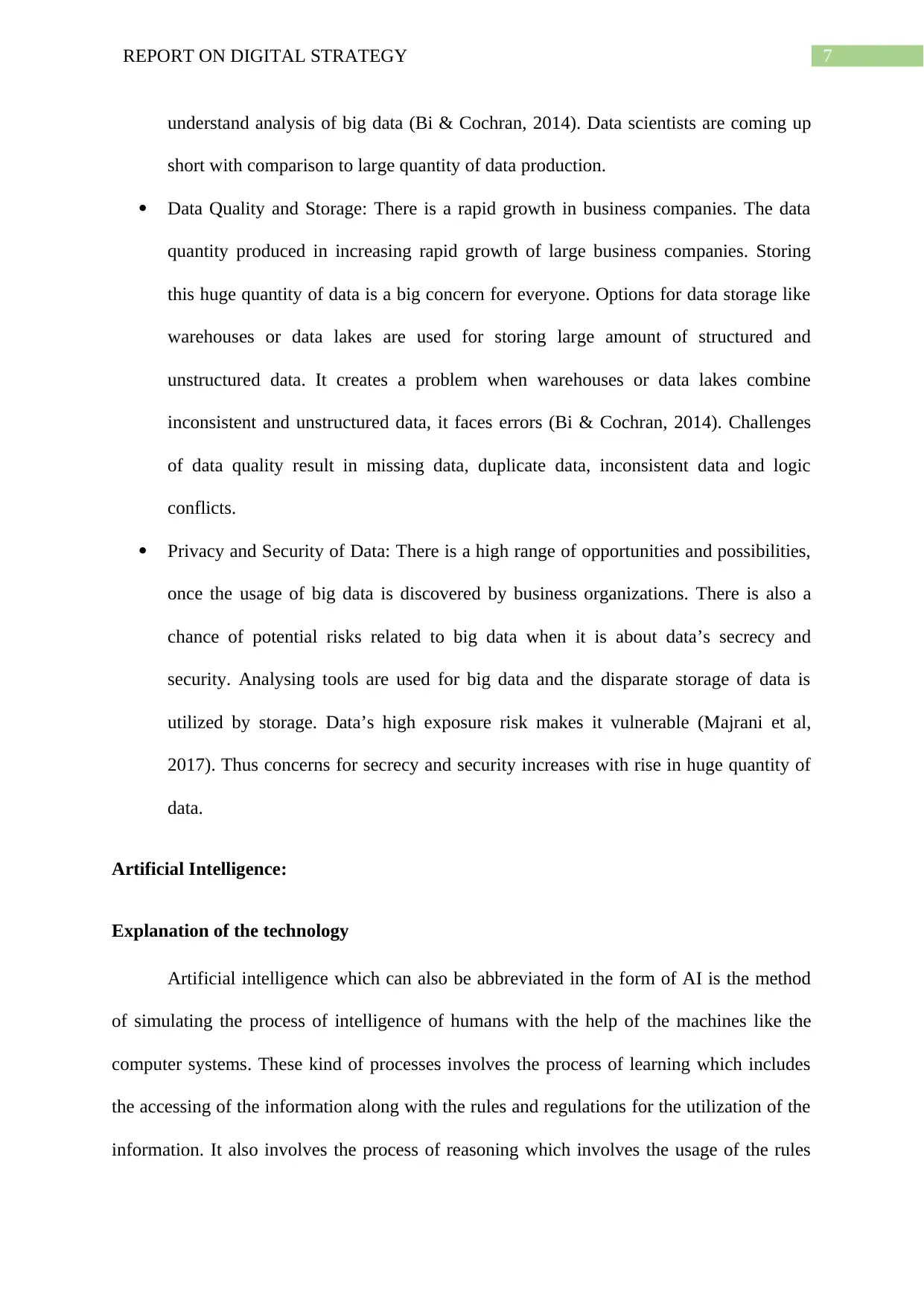
7REPORT ON DIGITAL STRATEGY
understand analysis of big data (Bi & Cochran, 2014). Data scientists are coming up
short with comparison to large quantity of data production.
Data Quality and Storage: There is a rapid growth in business companies. The data
quantity produced in increasing rapid growth of large business companies. Storing
this huge quantity of data is a big concern for everyone. Options for data storage like
warehouses or data lakes are used for storing large amount of structured and
unstructured data. It creates a problem when warehouses or data lakes combine
inconsistent and unstructured data, it faces errors (Bi & Cochran, 2014). Challenges
of data quality result in missing data, duplicate data, inconsistent data and logic
conflicts.
Privacy and Security of Data: There is a high range of opportunities and possibilities,
once the usage of big data is discovered by business organizations. There is also a
chance of potential risks related to big data when it is about data’s secrecy and
security. Analysing tools are used for big data and the disparate storage of data is
utilized by storage. Data’s high exposure risk makes it vulnerable (Majrani et al,
2017). Thus concerns for secrecy and security increases with rise in huge quantity of
data.
Artificial Intelligence:
Explanation of the technology
Artificial intelligence which can also be abbreviated in the form of AI is the method
of simulating the process of intelligence of humans with the help of the machines like the
computer systems. These kind of processes involves the process of learning which includes
the accessing of the information along with the rules and regulations for the utilization of the
information. It also involves the process of reasoning which involves the usage of the rules
understand analysis of big data (Bi & Cochran, 2014). Data scientists are coming up
short with comparison to large quantity of data production.
Data Quality and Storage: There is a rapid growth in business companies. The data
quantity produced in increasing rapid growth of large business companies. Storing
this huge quantity of data is a big concern for everyone. Options for data storage like
warehouses or data lakes are used for storing large amount of structured and
unstructured data. It creates a problem when warehouses or data lakes combine
inconsistent and unstructured data, it faces errors (Bi & Cochran, 2014). Challenges
of data quality result in missing data, duplicate data, inconsistent data and logic
conflicts.
Privacy and Security of Data: There is a high range of opportunities and possibilities,
once the usage of big data is discovered by business organizations. There is also a
chance of potential risks related to big data when it is about data’s secrecy and
security. Analysing tools are used for big data and the disparate storage of data is
utilized by storage. Data’s high exposure risk makes it vulnerable (Majrani et al,
2017). Thus concerns for secrecy and security increases with rise in huge quantity of
data.
Artificial Intelligence:
Explanation of the technology
Artificial intelligence which can also be abbreviated in the form of AI is the method
of simulating the process of intelligence of humans with the help of the machines like the
computer systems. These kind of processes involves the process of learning which includes
the accessing of the information along with the rules and regulations for the utilization of the
information. It also involves the process of reasoning which involves the usage of the rules
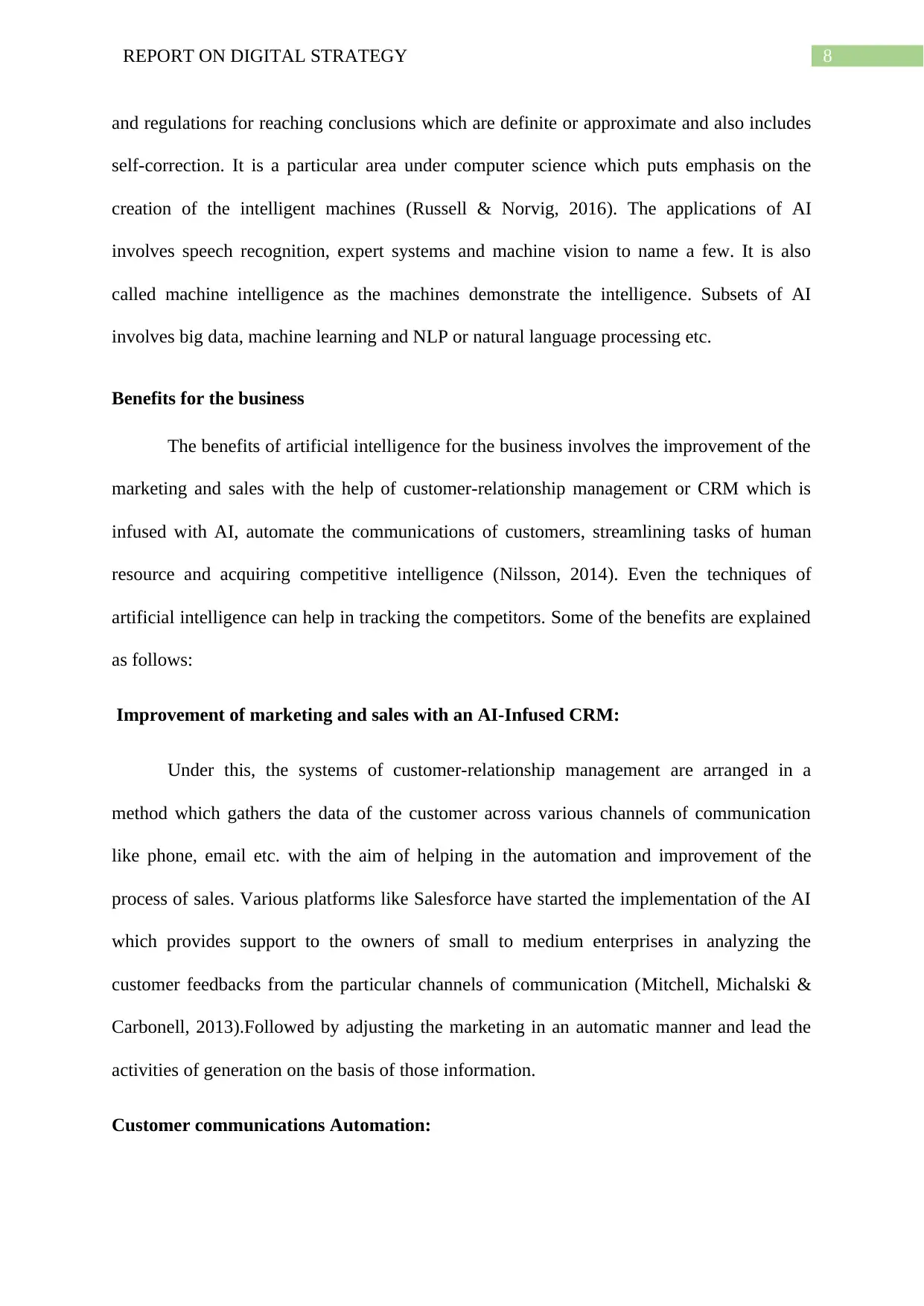
8REPORT ON DIGITAL STRATEGY
and regulations for reaching conclusions which are definite or approximate and also includes
self-correction. It is a particular area under computer science which puts emphasis on the
creation of the intelligent machines (Russell & Norvig, 2016). The applications of AI
involves speech recognition, expert systems and machine vision to name a few. It is also
called machine intelligence as the machines demonstrate the intelligence. Subsets of AI
involves big data, machine learning and NLP or natural language processing etc.
Benefits for the business
The benefits of artificial intelligence for the business involves the improvement of the
marketing and sales with the help of customer-relationship management or CRM which is
infused with AI, automate the communications of customers, streamlining tasks of human
resource and acquiring competitive intelligence (Nilsson, 2014). Even the techniques of
artificial intelligence can help in tracking the competitors. Some of the benefits are explained
as follows:
Improvement of marketing and sales with an AI-Infused CRM:
Under this, the systems of customer-relationship management are arranged in a
method which gathers the data of the customer across various channels of communication
like phone, email etc. with the aim of helping in the automation and improvement of the
process of sales. Various platforms like Salesforce have started the implementation of the AI
which provides support to the owners of small to medium enterprises in analyzing the
customer feedbacks from the particular channels of communication (Mitchell, Michalski &
Carbonell, 2013).Followed by adjusting the marketing in an automatic manner and lead the
activities of generation on the basis of those information.
Customer communications Automation:
and regulations for reaching conclusions which are definite or approximate and also includes
self-correction. It is a particular area under computer science which puts emphasis on the
creation of the intelligent machines (Russell & Norvig, 2016). The applications of AI
involves speech recognition, expert systems and machine vision to name a few. It is also
called machine intelligence as the machines demonstrate the intelligence. Subsets of AI
involves big data, machine learning and NLP or natural language processing etc.
Benefits for the business
The benefits of artificial intelligence for the business involves the improvement of the
marketing and sales with the help of customer-relationship management or CRM which is
infused with AI, automate the communications of customers, streamlining tasks of human
resource and acquiring competitive intelligence (Nilsson, 2014). Even the techniques of
artificial intelligence can help in tracking the competitors. Some of the benefits are explained
as follows:
Improvement of marketing and sales with an AI-Infused CRM:
Under this, the systems of customer-relationship management are arranged in a
method which gathers the data of the customer across various channels of communication
like phone, email etc. with the aim of helping in the automation and improvement of the
process of sales. Various platforms like Salesforce have started the implementation of the AI
which provides support to the owners of small to medium enterprises in analyzing the
customer feedbacks from the particular channels of communication (Mitchell, Michalski &
Carbonell, 2013).Followed by adjusting the marketing in an automatic manner and lead the
activities of generation on the basis of those information.
Customer communications Automation:
⊘ This is a preview!⊘
Do you want full access?
Subscribe today to unlock all pages.

Trusted by 1+ million students worldwide
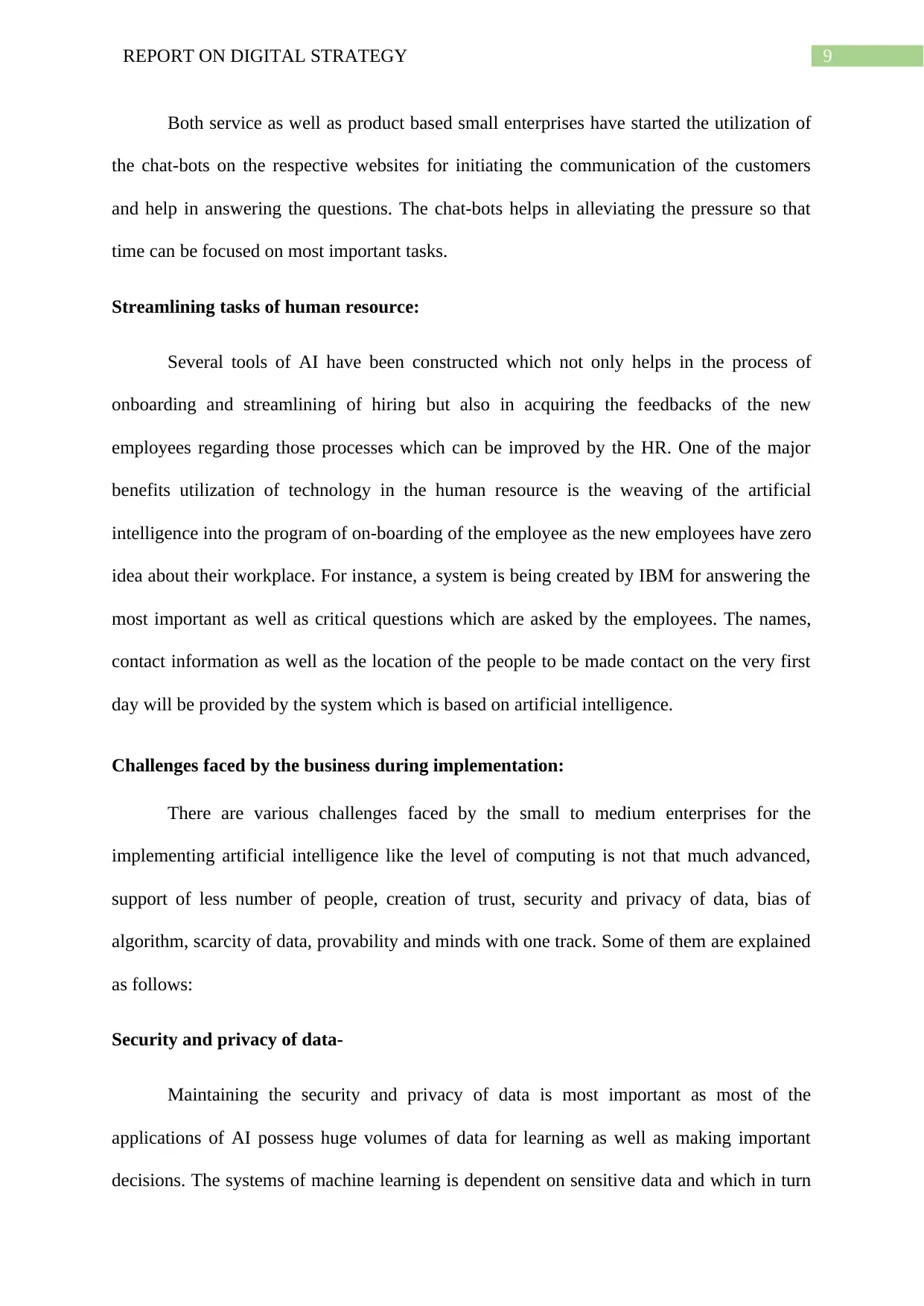
9REPORT ON DIGITAL STRATEGY
Both service as well as product based small enterprises have started the utilization of
the chat-bots on the respective websites for initiating the communication of the customers
and help in answering the questions. The chat-bots helps in alleviating the pressure so that
time can be focused on most important tasks.
Streamlining tasks of human resource:
Several tools of AI have been constructed which not only helps in the process of
onboarding and streamlining of hiring but also in acquiring the feedbacks of the new
employees regarding those processes which can be improved by the HR. One of the major
benefits utilization of technology in the human resource is the weaving of the artificial
intelligence into the program of on-boarding of the employee as the new employees have zero
idea about their workplace. For instance, a system is being created by IBM for answering the
most important as well as critical questions which are asked by the employees. The names,
contact information as well as the location of the people to be made contact on the very first
day will be provided by the system which is based on artificial intelligence.
Challenges faced by the business during implementation:
There are various challenges faced by the small to medium enterprises for the
implementing artificial intelligence like the level of computing is not that much advanced,
support of less number of people, creation of trust, security and privacy of data, bias of
algorithm, scarcity of data, provability and minds with one track. Some of them are explained
as follows:
Security and privacy of data-
Maintaining the security and privacy of data is most important as most of the
applications of AI possess huge volumes of data for learning as well as making important
decisions. The systems of machine learning is dependent on sensitive data and which in turn
Both service as well as product based small enterprises have started the utilization of
the chat-bots on the respective websites for initiating the communication of the customers
and help in answering the questions. The chat-bots helps in alleviating the pressure so that
time can be focused on most important tasks.
Streamlining tasks of human resource:
Several tools of AI have been constructed which not only helps in the process of
onboarding and streamlining of hiring but also in acquiring the feedbacks of the new
employees regarding those processes which can be improved by the HR. One of the major
benefits utilization of technology in the human resource is the weaving of the artificial
intelligence into the program of on-boarding of the employee as the new employees have zero
idea about their workplace. For instance, a system is being created by IBM for answering the
most important as well as critical questions which are asked by the employees. The names,
contact information as well as the location of the people to be made contact on the very first
day will be provided by the system which is based on artificial intelligence.
Challenges faced by the business during implementation:
There are various challenges faced by the small to medium enterprises for the
implementing artificial intelligence like the level of computing is not that much advanced,
support of less number of people, creation of trust, security and privacy of data, bias of
algorithm, scarcity of data, provability and minds with one track. Some of them are explained
as follows:
Security and privacy of data-
Maintaining the security and privacy of data is most important as most of the
applications of AI possess huge volumes of data for learning as well as making important
decisions. The systems of machine learning is dependent on sensitive data and which in turn
Paraphrase This Document
Need a fresh take? Get an instant paraphrase of this document with our AI Paraphraser
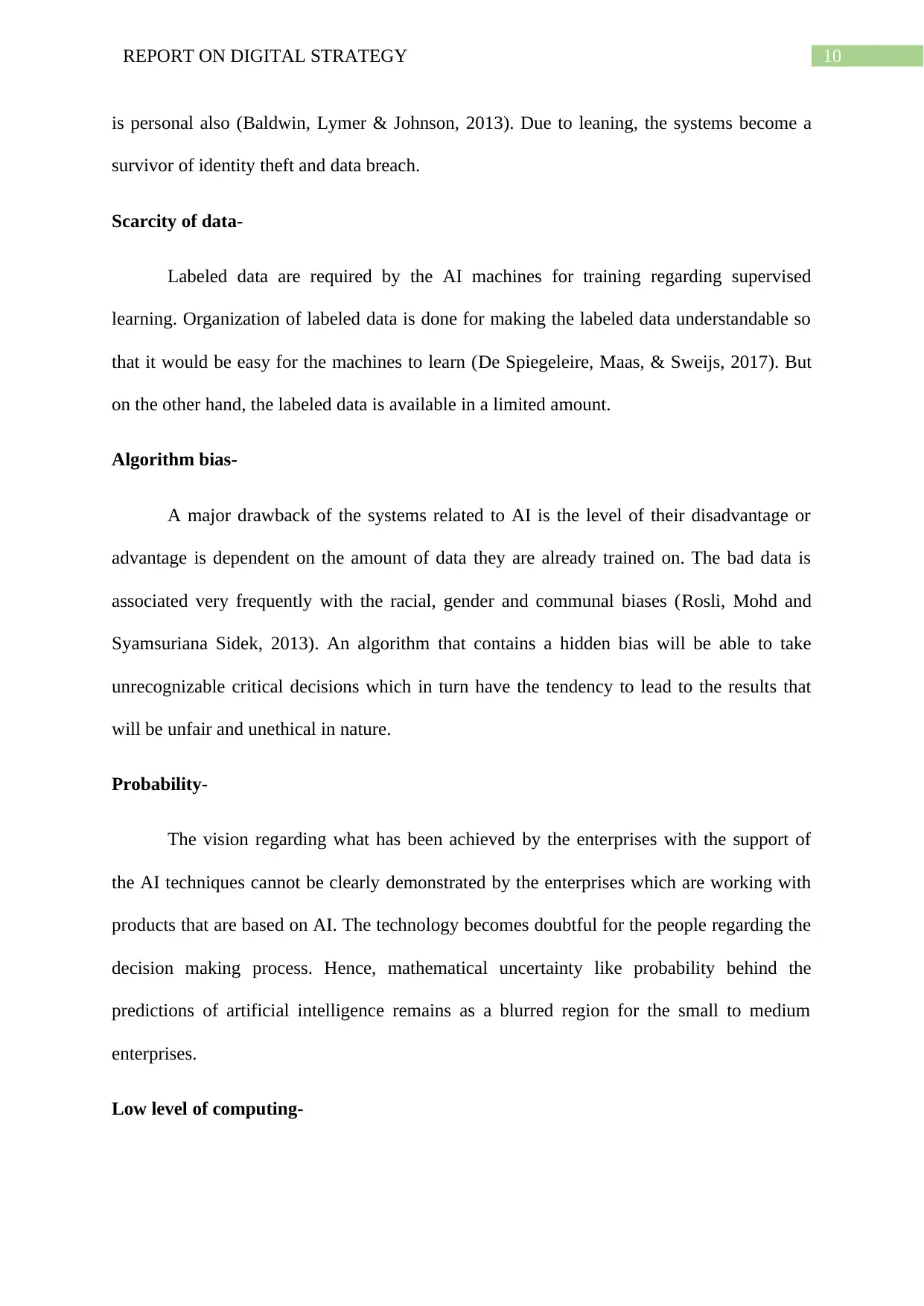
10REPORT ON DIGITAL STRATEGY
is personal also (Baldwin, Lymer & Johnson, 2013). Due to leaning, the systems become a
survivor of identity theft and data breach.
Scarcity of data-
Labeled data are required by the AI machines for training regarding supervised
learning. Organization of labeled data is done for making the labeled data understandable so
that it would be easy for the machines to learn (De Spiegeleire, Maas, & Sweijs, 2017). But
on the other hand, the labeled data is available in a limited amount.
Algorithm bias-
A major drawback of the systems related to AI is the level of their disadvantage or
advantage is dependent on the amount of data they are already trained on. The bad data is
associated very frequently with the racial, gender and communal biases (Rosli, Mohd and
Syamsuriana Sidek, 2013). An algorithm that contains a hidden bias will be able to take
unrecognizable critical decisions which in turn have the tendency to lead to the results that
will be unfair and unethical in nature.
Probability-
The vision regarding what has been achieved by the enterprises with the support of
the AI techniques cannot be clearly demonstrated by the enterprises which are working with
products that are based on AI. The technology becomes doubtful for the people regarding the
decision making process. Hence, mathematical uncertainty like probability behind the
predictions of artificial intelligence remains as a blurred region for the small to medium
enterprises.
Low level of computing-
is personal also (Baldwin, Lymer & Johnson, 2013). Due to leaning, the systems become a
survivor of identity theft and data breach.
Scarcity of data-
Labeled data are required by the AI machines for training regarding supervised
learning. Organization of labeled data is done for making the labeled data understandable so
that it would be easy for the machines to learn (De Spiegeleire, Maas, & Sweijs, 2017). But
on the other hand, the labeled data is available in a limited amount.
Algorithm bias-
A major drawback of the systems related to AI is the level of their disadvantage or
advantage is dependent on the amount of data they are already trained on. The bad data is
associated very frequently with the racial, gender and communal biases (Rosli, Mohd and
Syamsuriana Sidek, 2013). An algorithm that contains a hidden bias will be able to take
unrecognizable critical decisions which in turn have the tendency to lead to the results that
will be unfair and unethical in nature.
Probability-
The vision regarding what has been achieved by the enterprises with the support of
the AI techniques cannot be clearly demonstrated by the enterprises which are working with
products that are based on AI. The technology becomes doubtful for the people regarding the
decision making process. Hence, mathematical uncertainty like probability behind the
predictions of artificial intelligence remains as a blurred region for the small to medium
enterprises.
Low level of computing-
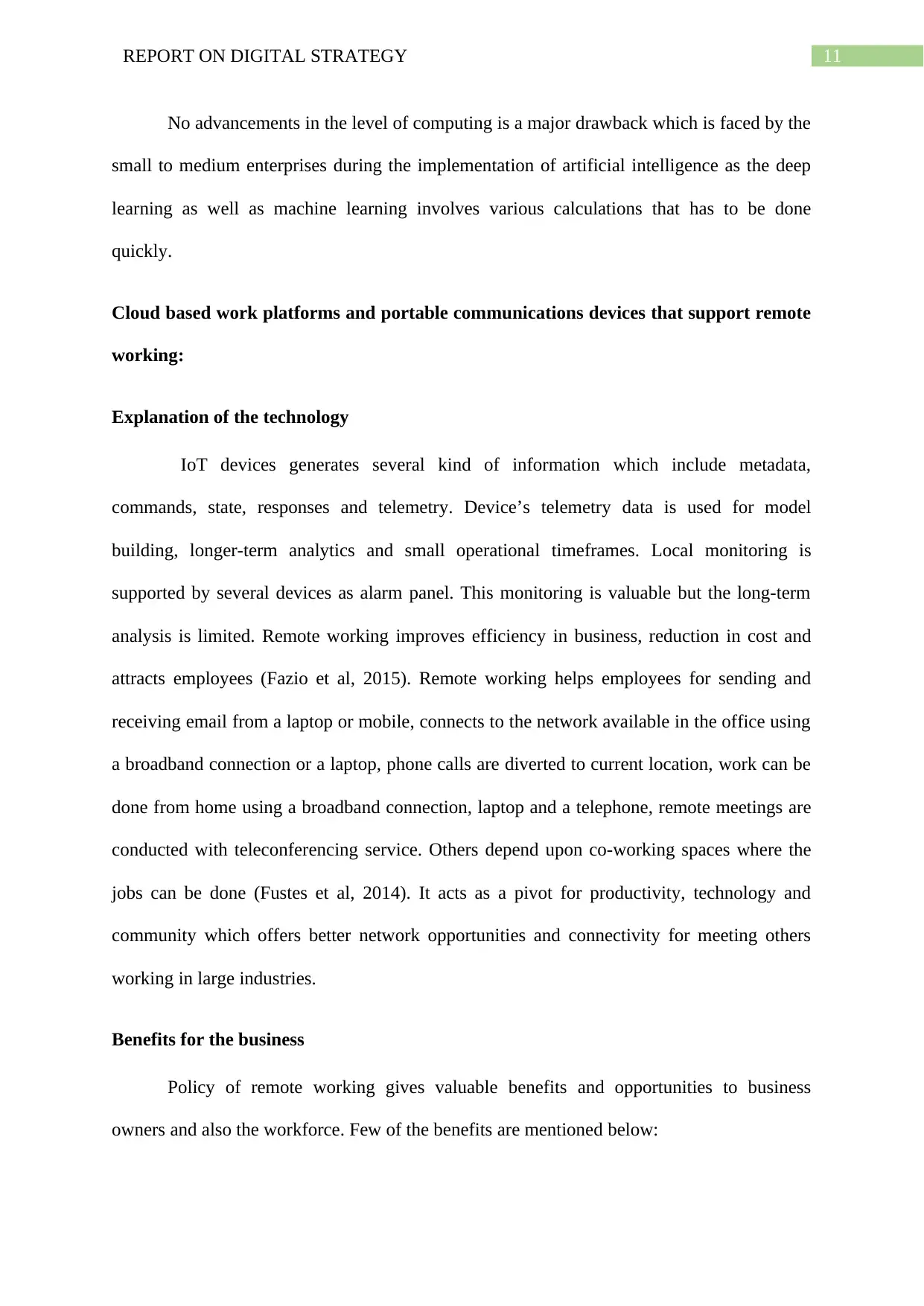
11REPORT ON DIGITAL STRATEGY
No advancements in the level of computing is a major drawback which is faced by the
small to medium enterprises during the implementation of artificial intelligence as the deep
learning as well as machine learning involves various calculations that has to be done
quickly.
Cloud based work platforms and portable communications devices that support remote
working:
Explanation of the technology
IoT devices generates several kind of information which include metadata,
commands, state, responses and telemetry. Device’s telemetry data is used for model
building, longer-term analytics and small operational timeframes. Local monitoring is
supported by several devices as alarm panel. This monitoring is valuable but the long-term
analysis is limited. Remote working improves efficiency in business, reduction in cost and
attracts employees (Fazio et al, 2015). Remote working helps employees for sending and
receiving email from a laptop or mobile, connects to the network available in the office using
a broadband connection or a laptop, phone calls are diverted to current location, work can be
done from home using a broadband connection, laptop and a telephone, remote meetings are
conducted with teleconferencing service. Others depend upon co-working spaces where the
jobs can be done (Fustes et al, 2014). It acts as a pivot for productivity, technology and
community which offers better network opportunities and connectivity for meeting others
working in large industries.
Benefits for the business
Policy of remote working gives valuable benefits and opportunities to business
owners and also the workforce. Few of the benefits are mentioned below:
No advancements in the level of computing is a major drawback which is faced by the
small to medium enterprises during the implementation of artificial intelligence as the deep
learning as well as machine learning involves various calculations that has to be done
quickly.
Cloud based work platforms and portable communications devices that support remote
working:
Explanation of the technology
IoT devices generates several kind of information which include metadata,
commands, state, responses and telemetry. Device’s telemetry data is used for model
building, longer-term analytics and small operational timeframes. Local monitoring is
supported by several devices as alarm panel. This monitoring is valuable but the long-term
analysis is limited. Remote working improves efficiency in business, reduction in cost and
attracts employees (Fazio et al, 2015). Remote working helps employees for sending and
receiving email from a laptop or mobile, connects to the network available in the office using
a broadband connection or a laptop, phone calls are diverted to current location, work can be
done from home using a broadband connection, laptop and a telephone, remote meetings are
conducted with teleconferencing service. Others depend upon co-working spaces where the
jobs can be done (Fustes et al, 2014). It acts as a pivot for productivity, technology and
community which offers better network opportunities and connectivity for meeting others
working in large industries.
Benefits for the business
Policy of remote working gives valuable benefits and opportunities to business
owners and also the workforce. Few of the benefits are mentioned below:
⊘ This is a preview!⊘
Do you want full access?
Subscribe today to unlock all pages.

Trusted by 1+ million students worldwide
1 out of 18
Related Documents
Your All-in-One AI-Powered Toolkit for Academic Success.
+13062052269
info@desklib.com
Available 24*7 on WhatsApp / Email
![[object Object]](/_next/static/media/star-bottom.7253800d.svg)
Unlock your academic potential
Copyright © 2020–2025 A2Z Services. All Rights Reserved. Developed and managed by ZUCOL.





